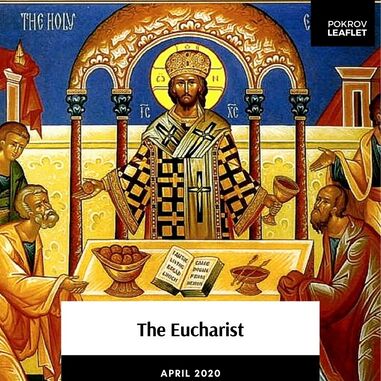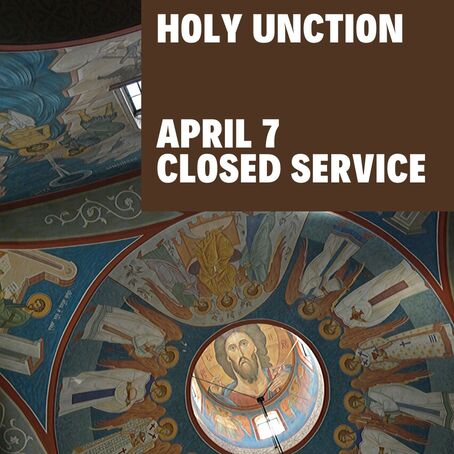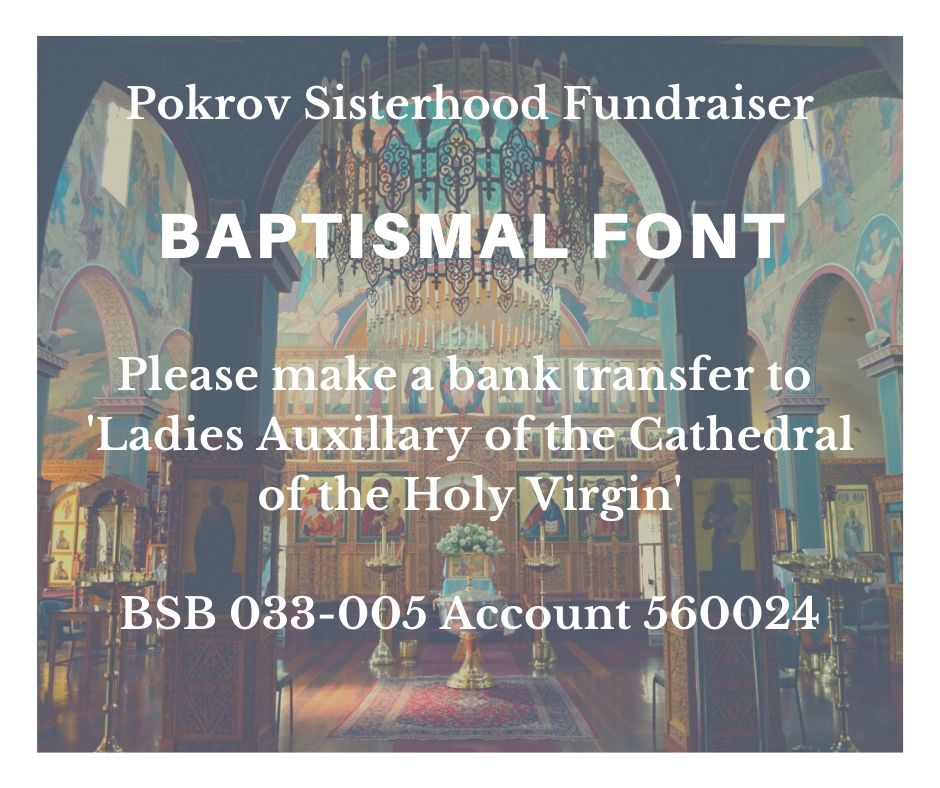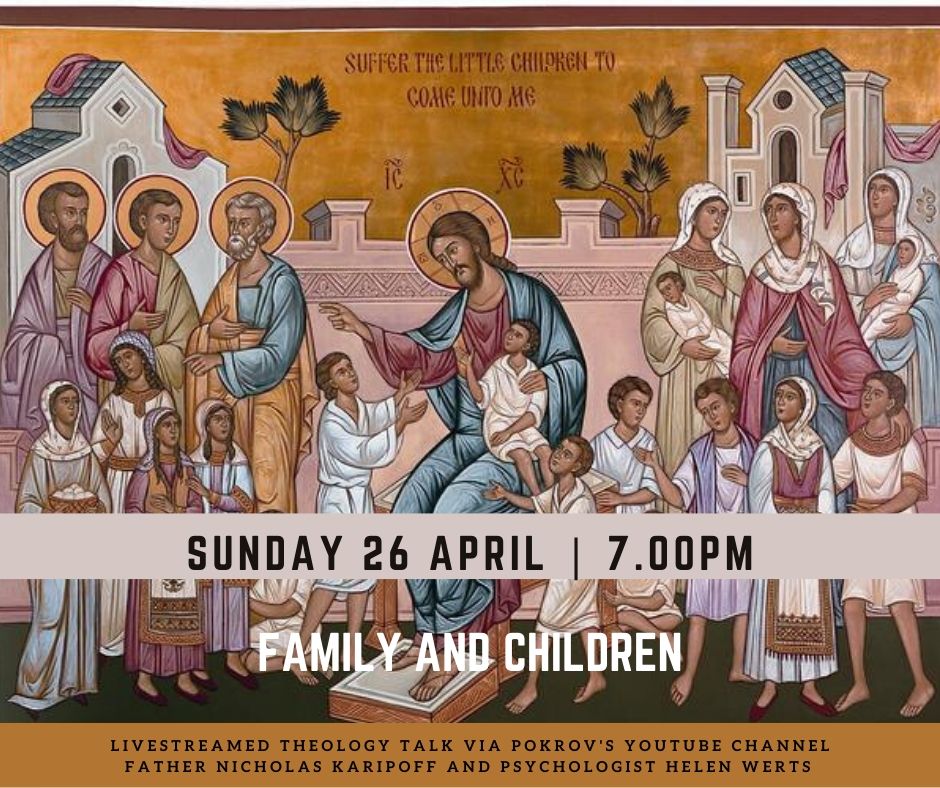|
Here is a list of things the Sisterhood does:
1. Decoration of the church - where else do you see such impressive displays of flowers? Go on, I'll wait 2. Running a full-size, industrial caterer's kitchen at church. Yes, those piroshki don't just fry themselves and that sugar bowl doesn't fill itself 3. Baking prosphora 4. Looking after all the vestments - and there are heaps! 5. Ensuring we have delicious food to feed hundreds on our patronal feast day 6. Providing help for the sick and ailing (with food and cooking), as well as the vulnerable (financially) 7. Fundraising for the church and here is how you can help: We are very blessed to have a growing number of catechumens and we don't want them to 'depart', we hope they will 'remain', and come home to the Orthodox Church. The sisterhood is fundraising for a baptismal font, please give generously!  Series on the Mysteries (Sacraments) THE EUCHARIST Christ is Risen! The central annual event of the Church calendar intimately connects with the Pascha of each week. Christians immediately began to ‘break the Bread’ on the first day of the week, the day of the Resurrection, Sunday. Gradually other festal occasions developed when the Church came together for the Eucharistic liturgy. The Gospels give us two main stories that are part of the revelation of Christ about His New Testament with all the nations. These stories speak of the fullness of life from God brought to Earth by the Saviour. The first story is the miracle of the five loaves and two fishes; the second, the story of the Mystical (‘Last’) Supper at which the Lord performed the one and only Eucharist. According to the teaching of the Orthodox Church when we serve the Eucharistic liturgy, we neither just ‘remember’ Christ’s story, not repeat what He did at the Supper with His disciples. The morning after the feeding of the multitudes Christ spoke at the Synagogue in Capernaum about the underlying meaning of that miracle (Jn 6:12-69). He said: “I am the bread of life” (Jn 6:48), making a distinction between the manna that was given to Israel in the wilderness which served only to sustain bodily life on earth – and the food of eternal life that He would give them. This food would be His Body and Blood. These words shocked many of Christ’s listeners and even some of His followers left Him (Jn 6:66). Yet what better way was there to express the intimacy of connection with God through Christ! What powerful expression of sacrificial love giving up itself for the sustenance of humanity beloved by God. The second event reveals even more about the meaning of salvation given by the Son of God. In the first instance, Christ’s audience in the synagogue asked Him for a sign, remembering that in the days of Moses manna was given to nourish Israel. His answer clearly indicates that everything about the story of Moses was only a prototype, a shadow of the real things to come. The Mystical Supper too, was celebrated by the Lord after the prototypical Passover meal. Its prayers or at last the ideas expressed in them became a structural basis for the New Testament Passover – the celebration of the Eucharist. Old Testament Passover celebrated the deliverance of the nation of Israel from the bondage of the Pharaoh. New Testament Passover (Pascha and the Eucharist) celebrates our deliverance from the Prince of death: “… instead of Moses, Christ is the salvation of our souls” (dogmatikon of the 2nd tone). Old Testament pact between God and Israel at the foot of Mt Sinai was sealed in the blood of sacrificed animals. Again, all of these sacrifices were only prototypes of the ultimate sacrifice of love – Christ crucified. He tells His disciples – and us – that the New Testament is in His blood. The shedding of His Blood is a many faceted phenomenon. It illustrates Christ’s own words that the greatest love one can have is to lay down one’s life for others (Jn 15:13). The Tree of the Cross becomes not only the sacrificial altar for the Lamb of God, but also the Tree of Life. This Tree – or Vine (Jn 15:5) – is Christ Himself, connecting us, the branches with the sap, the energies of God. The Eucharist as Passover/Pascha is clearly not only a thematic expression of the essence of Christianity as the promise of real life (1 Pet 1:18). It is an existential fact that this life comes from the inner life of the Father, the Son and the Holy Spirit – Unity in Trinity, one God. The Eucharist was perceived from the apostolic times as the medicine of eternity. This medicine gives an experiential perception of the healing of the inner wounds of each member of the Church and the restoration of the torn fabric of society caused by hate, animosity, aggressive competition, envy, jealousy and ultimately pride. Other religious cultures too see a connection between a shared meal and unity of life. An example of this is the custom of commemorating the dead in many pre-Christian cultures, involving eating and drinking on their behalf. The difference between that basic, correct intuition and the Eucharist of the Church is great. The Gospel, other New Testament books and the whole Bible give a huge picture of what Church teaching calls ‘God’s plan of salvation’. The Eucharist is central as an expression of that plan because it ‘remembers’ or enters symbolically into the life of Christ , but once we are connected with Christ in the Mystery we are also connected with spiritual bonds of love with each other. The ancient Christians saw it like this. We commune in the Body of Christ to become mystically part of Him and His Body – the Church. The separation between us due to our sinfulness disappears at least for a while as we experience a foretaste of unearthly harmony. The Eucharist is the main source of transformational grace in the life of the Church. However, personal effort of prayer and self-limitation has to be made in order for us to open to that grace. Christian life is very much about personal change, transformation. It is not about becoming ‘a better person’. It is about connecting with Christ. This short introduction will have to be followed up by a more detailed picture of the Eucharistic liturgy – later. Truly He is Risen! Archpriest Nicholas Karipoff ЕВХАРИСТИЯ Христос Воскресе! Центральное годовое событие церковного календаря тесно связано с Пасхой каждой недели. Христиане сразу же стали «преломлять хлеб» в первый день недели, в день воскресения Христа, в воскресенье. Постепенно и в другие возникшие праздничные дни Церковь стала собираться на евхаристическую литургию Евангелия рассказывают нам о двух важных событиях, которые являются частью откровения Христа - о Его Новом Завете для всех народов. Эти истории говорят о полноте жизни, принесённой от Бога на землю Спасителем. Первая история – рассказ о насыщении народа пятью хлебами и двумя рыбами; вторая – Тайная Вечеря, когда Господь совершил одну, единственную Евхаристию. По учению Православной Церкви, когда мы совершаем литургию, мы не просто «воспоминаем» историю Христа и не повторяем, что Он совершил на Тайной Вечери со Своими учениками. На следующее утро после чудесного насыщения народа Христос учил в Капернаумской синагоге, подчёркивая смысл этого чуда (Ин 6:22-69). Он сказал: «Я - Хлеб жизни» (Ин 6:48), указывая на разницу между манной, посланной Израилю в пустыни, которая только была необходима для физического поддержания жизни – и пищей вечной жизни, которую Он даст им. Это будет Его тело и Его кровь. Эти слова привели слушателей в ужас, и даже некоторые из следующих за Ним оставили Его (Ин 6:66). И однако, это был лучший способ, чтобы объяснить близость связи с Богом через Христа! Какое сильное выражение жертвенной любви, отдающей себя для питания человечества, любимого Богом. Второе событие открывает даже ещё больше о значении спасения, дарованного нам Сыном Божиим. Первая же просьба слушателей была, чтобы Христос дал им знамение, так как была послана манна, чтобы накормить народ. Его ответ ясно указывает на то, что весь рассказ о Моисее и манне был прототип, тень грядущих настоящих событий. Тайная Вечеря была совершена Христом после обряда еврейской Пасхи. Молитвы её, или по крайней мере, выражения тех молитв, легли в основу Пасхи Нового Завета – Евхаристии. Пасха Ветхого Завета праздновалась в воспоминание исхода Израиля из египетского плена. Пасха Нового Завета (Евхаристия) празднует наше избавление от князя смерти: «… вместо Моисея, Христос - спасение душ наших» (догматик 2-го гласа). Ветхий Завет – договор между Богом и Израилем у подножия Синайской горы был скреплён кровью жертвенных животных. И опять, все эти жертвы были только прототипами окончательной жертвы любви – распятием Христа. Он говорит Своим ученикам – и нам, что Новый Завет – в Его крови. Пролитие Его Крови – это многогранное событие. Это подтверждается собственным славами Спасителя: величайшая любовь – положить душу (жизнь) свою за друзей своих (Ин 15:13). Древо Креста стало не только жертвенником Агнца Божия, но также и Древом Жизни. Это Древо – или Лоза – сам Христос, связывающий нас, ветвей, с соком, с энергиями Бога. Евхаристия/Пасха – определённо не только тематическое выражение сущности христианства как обещания настоящей жизни (1 Петр 1:18). Реальный факт то, что эта жизнь дана из внутренней жизни Отца, Сына и Святого Духа – Единицы в Троице, Единого Бога. Евхаристия воспринималась с апостольских времён как лекарство вечности. Это лекарство даёт основанное на опыте восприятие исцеления внутренних ран каждого члена Церкви и восстановление разорванной грехом (ненавистью, злобой, агрессией, гордостью) ткани общества. В других религиозных культурах тоже существует связь между общей трапезой и единения в жизни. Пример этому - традиция поминать умерших за столом с едой и выпивкой, существовавшая во многих дохристианских культурах. Разница между этой основной и правильной интуицией и Евхаристией Церкви - огромная. Евангелие, другие книги Нового Завета и Библия в целом дают нам развёрнутую картину учения Церкви о так называемом «Божием плане спасения». Евхаристия – центральное выражение этого плана, потому что она «помнит» или вводит символически в жизнь Христа. Но как только мы соединяемся со Христом в таинстве, мы также соединяемся духовными узами любви друг со другом. Древние христиане это видели. Мы общаемся в Теле Христовом, таинственно становимся частью Его Тела и Крови – Церкви. Отчуждение между нами ввиду нашей греховности, смертности преодолевается хотя бы ненадолго от ощущения предвкушения неземной гармонии. Евхаристия – главный источник преображённой благодатью жизни Церкви. Однако, должны происходить собственные усилия в молитве и самоограничении, чтобы быть готовыми к принятию этой благодати. Христианская жизнь – это изменение, преображение себя. Но это не значит «стать лучше», а это значит быть со Христом. Это короткое введение об Евхаристии должно быть продолжено позже более подробно о самой литургии. Воистину Воскресе! Протоиерей Николай Карыпов
 Holy Unction will take place on Tuesday 7th April at 6pm. It will be a closed service for now, but we will complete the anointing part of the service face to face in church, at some point in the (hopefully) near future. If you can make the anointing please enter your name below. Children's names can be entered if they are old enough to have confession and can attend the actual anointing. |
Location |
|


